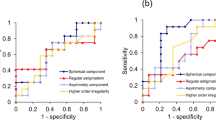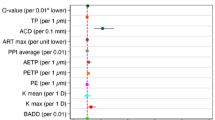Summary
Background: Semiquantitative classification of corneal topography after penetrating keratoplasty has the potential for focusing information about the areal dioptric power of the cornea. The purpose of this study was to objectify the procedure of manual semiquantitative classification using a Fourier transform of corneal topography power data and to correlate both methods.
Patients and methods: Fifty patients each (30 keratoconus, 20 Fuchs dystrophy) underwent nonmechanical trephination (excimer laser MEL60, Aesculap-Meditec, Jena) in penetrating keratoplasty. All procedures (7.5-mm trephination diameter in Fuchs, 8.0 mm in keratoconus, double-running 10–0 nylon suture) were done by one surgeon. Pre-, intra- and postoperative treatment were identical. At the follow-up examinations, the keratometric astigmatism, qualitative and quantitative criteria of the automatic videokeratography, visual acuity and refraction were assessed. Corneal topography was classified both manually and based on Fourier coefficients.
Results: After a mean follow-up of 24 ± 5 months, keratometric net astigmatism was 3.0 and 2.7 D with keratoconus and Fuchs dystrophy. Corneal topography analysis showed a higher orthogonality of the bow-tie shape and less asymmetry between opposite hemimeridians with increasing follow-up after keratoplasty. The semiquantitative classification showed a statistically significant correlation with the classification based on Fourier coefficients, especially with higher astigmatism and after suture removal (P = 0.04/0.01 before/after suture removal).
Discussion: After nonmechanical trephination, the semiquantitative classification of corneal topography can be synthetized using Fourier analysis of corneal dioptric power data. In the future, this method may be favored for prediction of potential best-corrected visual acuity after penetrating keratoplasty.
Zusammenfassung
Hintergrund: Die semiquantitative Klassifizierung der Hornhauttopographie nach perforierender Keratoplastik bietet die Möglichkeit, neben dem keratometrischen oder topographischen Astigmatismusbetrag gebündelt Information über die flächige Brechkraftentwicklung der Hornhaut zu erhalten. Ziel der Studie war, den subjektiven semiquantitativen Prozeß der Klassifizierung auf der Basis von Fourier-Koeffizienten zu objektivieren und mit der subjektiven Klassifizierung zu korrelieren.
Patienten und Methode: 50 Patienten (30 mit Keratokonus, 20 mit Fuchsscher Dystrophie) unterzogen sich einer nichtmechanischen Trepanation (Excimer-Laser MEL60, Aesculap-Meditec, Jena) im Rahmen einer perforierenden Keratoplastik. Alle Eingriffe (7,5 mm Trepanationsdurchmesser bei Fuchs, 8,0 mm bei Keratokonus, doppelt fortlaufende 10–0-Nylonnaht) wurden von demselben Operateur durchgeführt, prä-, intra- sowie postoperative Behandlung waren identisch. Im postoperativen Verlauf wurde der keratometrische Netto-Astigmatismus, die automatisierte Hornhauttopographieanalyse qualitativ und quantitativ sowie die Sehschärfe und Refraktion erfaßt. Die Hornhauttopographie wurde manuell semiquantitativ und auf der Basis von Fourier-Koeffizienten klassifiziert.
Ergebnisse: Nach einer Beobachtungsdauer von 24 ± 5 Monaten stabilisierte sich der keratometrische Netto-Astigmatismus bei 3,0 bzw. 2,7 Dioptrien bei Keratokonus bzw. Fuchsscher Dystrophie. Qualitativ zeigte die Hornhauttopographie eine Regularisierung im zeitlichen Verlauf im Sinne einer Tendenz hin zu höherer Orthogonalität der Doppelkeulenstruktur sowie zu geringerer Unsymmetrie der Brechkräfte in gegenüberliegenden Hemimeridianen. Die semiquantitative Klassifizierung zeigte eine statistisch sichere Übereinstimmung mit der Klassifizierung auf der Basis von Fourier-Koeffizienten, besonders bei hohem Astigmatismus und nach Fadenentfernung (p = 0,04/0,01 vor/nach Fadenentfernung).
Schlußfolgerung: Nach nichtmechanischer Keratoplastik läßt sich die semiquantitative Klassifizierung der Hornhauttopographie insbesondere bei höheren Astigmatismuswerten mit hoher statistischer Sicherheit aus den Fourier-Koeffizienten ableiten. Zukünftig könnte dieses Verfahren zur Abschätzung des potentiellen Visus nach Keratoplastik beitragen.
Similar content being viewed by others
Author information
Authors and Affiliations
Rights and permissions
About this article
Cite this article
Langenbucher, A., Seitz, B., Kus, M. et al. Classification of corneal topography after penetrating keratoplasty. Ophthalmologe 95, 741–747 (1998). https://doi.org/10.1007/s003470050346
Published:
Issue Date:
DOI: https://doi.org/10.1007/s003470050346




